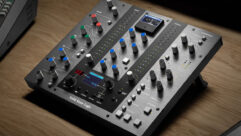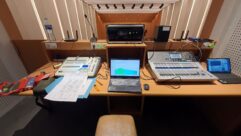
SÃO PAULO, BRAZIL – JANUARY 2016: What aspect of sound for pictures doesn’t Marcelo Cyro have a role in? A native of São Paulo, Brazil, Cyro graduated from the SAE Institute, Netherlands with an emphasis on mixing and mastering for surround. He studied in Koln and Paris and worked for a decade doing post-production audio for advertising, with clients such as Visa, MasterCard, Pepsi, GM, and Volkswagen. In São Paulo Cyro became a partner in the high-profile, audio post-production facility WeCanDo Audio Post, where he oversees editing, ADR, sound design, Foley creation & editing, mixing, and mastering. WeCanDo’s credits include the Brazilian movies Chatô, Apnéia, Farewell, and Jonas; cartoon series such as Gemini 8 (Brazil’s first Disney production), Luna’s Show (Discovery Kids) and other projects, such as Sitio do Pica-Pau Amarelo (Brazil’s first 5.1 cartoon); A Boy and the World, Open Road, and Cidade-cinza. As if that weren’t enough, Cyro also devotes his talents and time to teaching the next generation of audio professionals through MusicBit (www.musicbit.com.br).

Twice a month, Cyro creates a new video and a newsletter that takes budding professionals through a different aspect of sound for picture. Although the specifics in most of the lessons focus on the technical details of working with sound, the broader focus is always on storytelling. “What is the most important aspect of a movie, a TV show, or a cartoon?” he asked. “It’s always about telling a good story! That’s what we do; we use sound to create real or unreal worlds. We use sound to make the scene believable or unbelievable. As George Lucas said, sound is fifty-percent of a movie! We teach students how post-production audio works behind the scenes, but we always bring it back to the all-important goal of storytelling.”
Because Cyro uses Metric Halo Production Bundle plug-ins for every project he works on, he also uses them in his WeCanDo’s video tutorials. “In most sound for picture, the most important element is dialog,” he said. “I have two important steps in my dialog chain, and both rely on the solid sound and flexibility of Metric Halo ChannelStrip 3.” The first step corrects for the common problems found in most production audio dialog tracks. He typically high-pass filters the track somewhere around 90Hz and uses ChannelStrip 3’s integrated spectrum analyzer to identify and correct problem frequencies, either with equalization alone, broadband compression, or frequency-conscious compression. “Metric Halo’s software controls are a lot like real analog controls,” he said. “You can feel the change when you turn the knob, and yet the phasing stays lock-solid. The body of the sound remains intact.”
In the second phase, Cyro sweetens and highlights those aspects of the dialog that underscore the emotion and sharpen the intelligibility. “I accentuate the low frequencies that provide body to the voice without adding mud,” he said. “I also usually pull out some frequencies around 3kHz, which is typically too harsh, especially in the context of cinema. I add some air up past 12kHz and include a little bit of colorful compression with variable attack to add presence.” Of course, every recording is different, and thus Cyro adjusts those ingredients in varying degrees.
“When dialog comes in that is poorly recorded, I usually turn to Metric Halo’s Multiband Dynamics so that I can control frequency content without pulling those problematic frequencies out at quieter instances,” he continued. “That’s especially useful for surgically-removing mud in the 200Hz to 500Hz region without removing the body of the voice. I also use it when there’s too much midrange and simple equalization would damage the presence of the voice. I also use Metric Halo’s Precision De-Esser like a multi-band compressor to smooth out other problematic consonants, not just “s” and “t”. I use its spectrum analyzer to identify the problem frequencies. It works perfectly.”
Sound effects also play a critical role in the believability of a story, and Cyro has discovered that Metric Halo’s TransientControl can work magic on Foley tracks. Foley tracks are studio re-recordings of the ambient sounds in a scene, such as footsteps, key jingles, clothing movement, and the like. “The main idea with Foley is that you feel it, but that you don’t consciously hear it,” Cyro said. “Foley allows you to create sensations, feelings, and entire environments. TransientControl on the Foley track adds just the right element of articulation without requiring a lot of volume. That way, the Foley track can sit comfortably in the mix and do its job without calling attention to itself.”
Cyro also draws on the unique features of Metric Halo plug-ins to create special effects. “I like getting creative with sound when it’s called for,” he said. “I’ll often use Metric Halo Character to saturate a sound and then run it into HaloVerb. It’s an explosive effect that sounds especially huge in surround. I’ll sometimes add Dirty Delay to the chain, with the delays just in the rear speakers. Immense sounds, both subtle and over the top, are possible with Character, HaloVerb, and Dirty Delay. Thump (Metric Halo’s free plug-in) adds sub-harmonics to a signal, and sometimes I’ll put it in that same chain or use it by itself on the subwoofer channel.”
But whatever Cyro does with audio for pictures, whether it’s surgical edits to dialog or sound effects that leap from the screen, he always starts and ends with the story. “It’s too easy to get mired down in the technical details and to forget that everything serves the story,” he said. “I like Metric Halo’s plug-ins because they allow me to work quickly and intuitively, which is ultimately less distracting. I’m able to stay focused on the story!”
ABOUT METRIC HALO
Based on the Gulf Coast of Florida, Metric Halo provides the world with award-winning software and hardware recording, processing, metering and analysis solutions.
www.mhlabs.com
FOR MORE INFORMATION VISIT:
www.musicbit.com.br
www.wcdaudio.com










